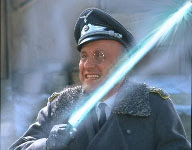(WARNING! I GO OFF ON A TANGENT HALF WAY THROUGH...)
Here's a quick review of a book that I recently picked up and was delighted with: 'The Trains we Loved' by C. Hamilton Ellis, yet another distinguished railway author (and painter) who is almost as well known as O.S. Nock (probably the best known of them all).
This particular book was published in 1947, has had its name taken by a more recent book by David St John Thomas and is most assuredly NOT the same book. Both, however, have something in common: they are overwash with NOSTALGIA. This is in effect what makes both books so interesting especially for modern readers who have never seen the railways when worked by steam.
While the newer book is awash with information about the experiences of the author in BR days, this older book has crucial memories of a life that began over a century ago: in the days of the pre-grouping powers: the famous LNWR, Midland, London and South Western, original GWR and the North British are but a few of the long-gone railways discussed in wonderfully descriptive prose that can only come from someone who saw the railways in action as a boy.
What makes this book thereby so important to modern eyes is the fact that few traces remain of these lines: a mediocre number of pre-grouping locomotives have survived, and fewer in active service: for example, the LNWR has just one locomotive surviving from its 20th Century stock (the recently overhauled 'G2').
One thing that is different about Ellis' (and O.S Nock's) books is how different they are to modern treatises on such subjects (say, a modern author's take on the Highland Railway will be matter-of-fact and be based on research- and author's viewpoint- rather than the experience of engines/system in action and the benifit of first hand observation of the line compared to other such lines). Mr Ellis is only to happy to label things as good or bad -or even both!-in his view, whereas most authors tend to be biased but not deliberately involved. Here is a fine passage which illustrates what I mean. Ellis writes as if describing something in a novel:
Crossing London River, the railway system of Kent was one of the most individual, most important, best of a kind, worst of a kind, most delightful and most detestable in Great Britain.
However, The Trains we loved is a superb tome nonetheless. It is even better when added to Mr Ellis 'Some classic locomotives', which describe a number of types of locomotive- not classes, but designs, such as the beyer-garratt, the Crampton, the 4-6-0 etc (one highly interesting part is given to Ellis' musings on idiotic names applied to some wheel arrangements, such as 'American'for the 4-4-0. He gives the lovely name 'Old English' to the 2-4-0: would that enthusiasts take it up!).
As with all Ellis' texts, there are superb colour paintings to accompany it. Given colour photos of the engines shown are RARE if not NON-EXSISTANT, then these pictures are especially important!
Overall, a superb book- that I mark down solely for Mr Ellis' historical accuracy on some things (apart from the Webb thing I can't bring up the others offhand, but there are some. I think...)
GET A COPY!
9/10
As always, I can assist buyers in tracking it down- ebay is of no use here most of the time.



0 comments:
Post a Comment